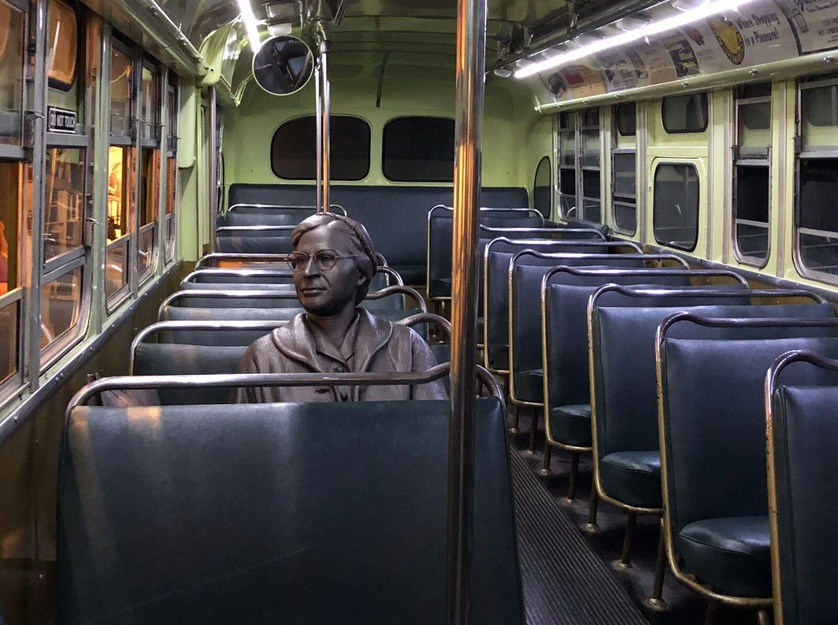
Traveler: Celebrating Dr. King’s Legacy At The National Civil Rights Museum
Walking the city streets, it’s almost impossible not to feel the ghosts of past civil-rights battles lingering. Local African-Americans held sit-in protests throughout the city’s libraries, department stores, and lunch counters urging the end of their segregation policies. (It worked. Memphis public libraries were desegregated in 1960, although other, privately owned businesses took a little longer.) In fact, Dr. Martin Luther King Jr. was in town to take part in a sanitation workers’ strike when he was assassinated by James Earl Ray on April 4, 1968.
Located in the same Lorraine Motel where King was murdered, the National Civil Rights Museum explores his legacy and that of the other heroes who fought for equality. Walking through the corridors, visitors explore the history of slavery, the reconstruction era and birth of Jim Crow laws, before reaching the present day. Visitors can board a period-specific bus, where they see statues of Rosa Parks and the bus driver who ordered her to the back of the bus. Nearby, there’s a similar life-sized exhibit featuring lunch counter protestors being menaced by angry segregationists. Many of the exhibits are interactive, allowing you to hear the civil-rights pioneers in their own voices.
As someone who hadn’t been born when the bulk of the protests occurred, the exhibits were eye opening. In school, most of the events weren’t discussed, and the ones that were had been softened and sanitized. Based on many history books, one might be led to believe that King’s iconic “I Have a Dream” speech ended racism as we know it. Exhibit after exhibit presents an embarrassing history that’s been largely swept under the rug in the years since. I was initially shocked to see that our government responded to the most violent reactions to protests – Freedom Riders being brutally beaten and peaceful protestors doused with fire hoses and attacked by dogs – not by taking action to stop it, but by merely trying to keep it out of the public eye. Sadly, 50 years later, it doesn’t seem things haven’t changed much.
Is it kid friendly? Because of the brutal nature of some of the exhibits, the museum may not be appropriate for children 11 years old and under. Despite the ugliness of the era, the experience is ultimately uplifting, but expect to have some possibly difficult conversations with your family afterward. Remember: Not every trip will be to Disneyland, nor should it; at its best, travel is a vehicle for personal growth and understanding of others.
After the Civil-Rights Museum, visit the Withers Collection on the legendary Beale Street. A former Memphis police officer, the late Ernest Withers captured the action and turbulence of the times, becoming King’s personal photographer and traveling with him on some of his most turbulent trips, including Selma and Montgomery.
Withers took an estimated 5,000,000 images during his career, but expect to see about a few hundred on display at the gallery at any given time. (Prints are available for purchase.) In addition to his best-known shots from the civil-rights movement, he took thousands of photos of baseball players in the waning days of the Negro Leagues. He was also the staff photographer for local Stax Records, capturing iconic images of Tina Turner, Isaac Hayes, and dozens of other artists. Plan to devote an hour to the gallery, leave a suggested donation of $10, and then hit the music clubs surrounding it.
Finally, head to the corner of Hernando Street and Pontotoc Avenue near the Clayborn Temple where King gave his last public speech. Memphis is finishing work on the $1.5 million interactive “I Am A Man” plaza, named after the rallying cry of the striking sanitation workers. Plaza designers say their goal was to “invite all people to a peaceful, interactive, and educational experience that supports the advancement of equity, justice and positive social change.” Workers are currently rushing to finish it in time for the anniversary activities last month.
Where to Stay: The boutique Hotel Napoleon is minutes away from most downtown Memphis attractions, but with its sleek and modern furnishings and some of the friendliest staff I’ve ever encountered, the hotel’s a draw on its own. While you’re waiting for your Lyft, take a minute or three to sift through the archived editions of the Memphis Press Scimitar and read about civil rights activities as they actually happened.
Where to Eat: The Arcade Restaurant claims to be Memphis’ oldest cafe and is just steps away from the Civil Rights Museum. Expect pretty standard diner fare, but the surrounding atmosphere makes it worth a visit. If you’re looking for Memphis BBQ, Charlie Vergos Rendezvous is the birthplace of Memphis dry-rub ribs and favorite of both hungry locals and visiting meat lovers. The generous ribs and brisket combo could feed three people.





